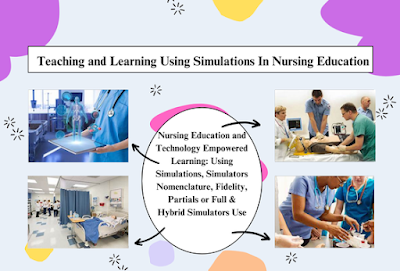The Technology Empowered Learning Using Simulations Simulators Nomenclature Fidelity Partials or Full and Hybrid Simulators Use In Nursing Education. Simulation provides the opportunity to acquire and apply knowledge and skills through the use of simulators, standardized patients, and virtual environments.
The Technology Empowered Learning Using Simulations Simulators Nomenclature Fidelity Partials or Full and Hybrid Simulators Use In Nursing Education
Simulation-based learning uses technology and realistic scenarios to replicate real-life situations. This provides nursing students with a safe space to practice skills and make mistakes without harming patients. This approach promotes clinical competence and critical thinking. Simulations range from partial-task trainers to full-body mannequins and virtual reality with varying degrees of accuracy. Hybrid simulations combine different modalities, while virtual reality simulations immerse students in virtual clinical environments.
Introduction to Simulations in Nursing Education
The evolving complexities of healthcare, coupled with a diverse patient population, necessitate advanced preparation for nursing students. To address the challenges of providing comprehensive clinical experiences, nursing educators are turning to simulations. These tools offer a controlled environment for students to practice and refine their skills, bridging the gap between theoretical knowledge and real-world application.
The Importance of Simulations
Simulations in nursing education replicate real-life scenarios, allowing students to engage in practical learning without the risks associated with actual patient care. This method supports critical thinking, problem-solving, and clinical reasoning in a safe, interactive setting. With healthcare increasingly shifting to community settings, simulations have become an invaluable alternative to traditional clinical experiences.
Types of Simulations and Their Benefits
-
Simulation Nomenclature and Fidelity
- Low Fidelity: Basic simulations such as case studies, role-playing, or using partial task trainers (e.g., plastic arms for venipuncture) fall into this category. These simulations offer a foundational understanding of patient care but lack high-level realism.
- Medium Fidelity: These simulations offer a more sophisticated experience, including manikins that can simulate basic physiological responses like heart and breath sounds, though they do not exhibit full physical movement.
- High Fidelity: High-fidelity simulations involve advanced, full-scale manikins or virtual reality systems that provide a high degree of realism. These simulators can mimic various patient conditions and responses, offering a comprehensive and interactive learning experience.
-
Partial vs. Full-Context Simulations
- Partial Task Trainers: Focus on specific skills or body parts, such as IV cannulation arms or wound care trainers. They allow students to practice discrete tasks and techniques.
- Full-Context Simulations: Replicate complete clinical scenarios, from patient interactions to the management of complex conditions. These simulations range from medium to high fidelity and are used to immerse students in realistic scenarios.
Hybrid Simulations
Hybrid simulations combine standardized patients (actors) with patient simulators to enhance realism. For instance, a scenario might begin with a student taking a medical history from an actor and then shift to a manikin to demonstrate advanced clinical symptoms.
Unfolding Case Simulations
Unfolding case simulations present scenarios that evolve over time, allowing students to manage ongoing care across different stages of a patient’s condition. These cases help learners understand the progression of health issues and refine their care strategies through multiple, interconnected events.
Conclusion
Incorporating simulations into nursing education offers numerous benefits, including enhanced skill acquisition, improved critical thinking, and a safer learning environment. As technology advances, the integration of simulations into nursing curricula will continue to play a crucial role in preparing students for the complexities of modern healthcare.
Read More:
https://nurseseducator.com/didactic-and-dialectic-teaching-rationale-for-team-based-learning/
https://nurseseducator.com/high-fidelity-simulation-use-in-nursing-education/
First NCLEX Exam Center In Pakistan From Lahore (Mall of Lahore) to the Global Nursing
Categories of Journals: W, X, Y and Z Category Journal In Nursing Education
AI in Healthcare Content Creation: A Double-Edged Sword and Scary
Social Links:
https://www.facebook.com/nurseseducator/
https://www.instagram.com/nurseseducator/
https://www.pinterest.com/NursesEducator/
https://www.linkedin.com/in/nurseseducator/
https://www.researchgate.net/profile/Afza-Lal-Din
https://scholar.google.com/citations?hl=en&user=F0XY9vQAAAAJ
